Nature & Conservation
As the majority of the National Park is located within the Twelve Bens/Garraun Complex Special Area of Conservation, the primary focus of the National Park is to maintain or restore the favourable conservation status of all priority habitats and species found therein.
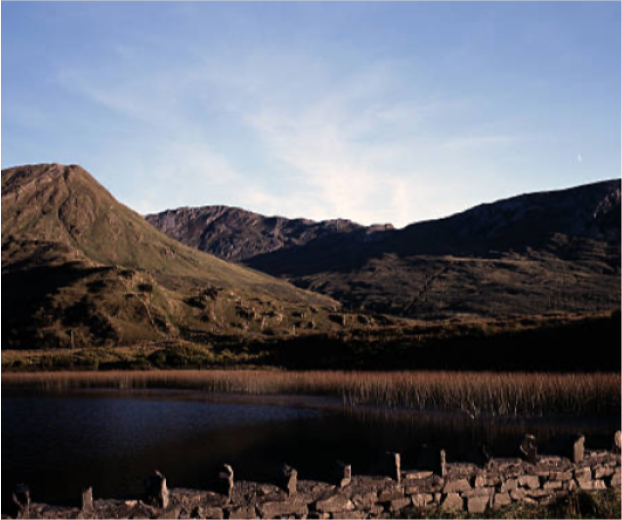
Situated in the West of Ireland in County Galway, Connemara National Park covers some 2,000 hectares of scenic mountains, expanses of bogs, heaths, grasslands and woodlands. Some of the Park’s mountains, namely Benbaun, Bencullagh, Benbrack and Muckanaght, are part of the famous Twelve Bens or Beanna Beola range. Connemara National Park was established and opened to the public in 1980.
Which such a diverse and plentiful landscape on our doorstep, Connemara National Park is home to various flora and fauna, as well as unique heritage breeds. This wildlife and livestock, paired with the diverse and cultural heritage of the Park, inspires and motivates us in our nature and conservation efforts and projects.
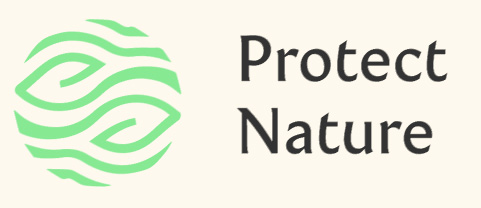
Thank you for helping us protect nature at Connemara National Park. When you enjoy responsible outdoor recreation here, you help us preserve the unique creatures and habitats of Connemara.
Conservation Projects
Project 01: Control of Rhododendron
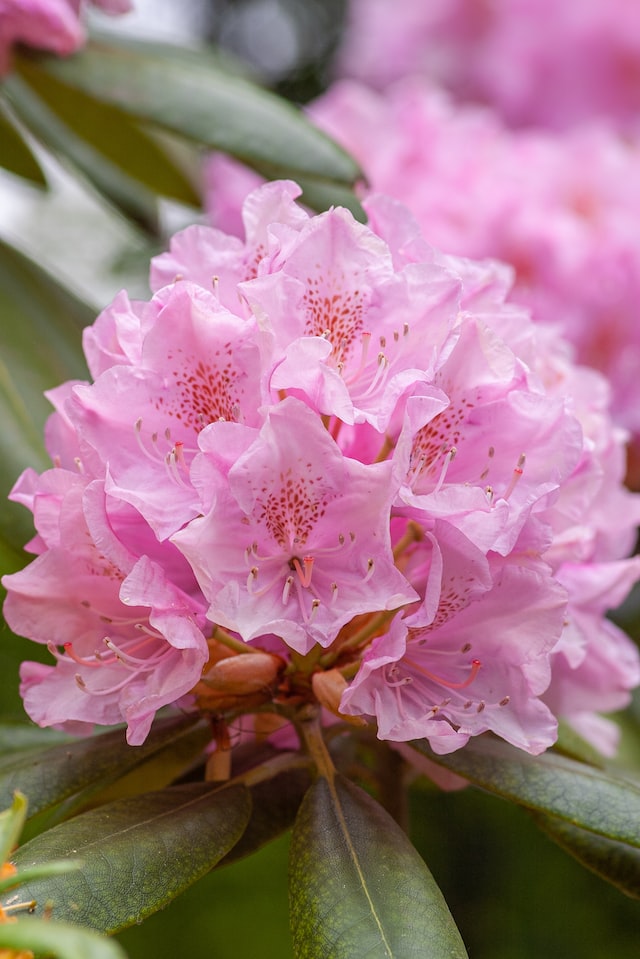
Above: Rhododendron
Project 01: Control of Rhododendron
The removal of Rhododendron from the National Park is important work in protecting nature and restoring native biodiversity. This ongoing and labour intensive work has been undertaken over the last two winters in the National Park.
Rhododendron ponticum is a non-native, invasive species found within the National Park. It was originally introduced into Ireland as a garden plant in the 18th century. It prefers the wet and acid peaty soils found on the western seaboard of Ireland. It is an evergreen shrub with bright pink flowers, fast growing, and quickly shades out all native vegetation growing below it. To conserve areas of important wet heath and regenerating woodland it’s imperative to control it by cutting and treating with herbicide in a controlled manner.
A guide to management of the species can be downloaded for the National Parks website

Project 02: Mweelin Exclosure
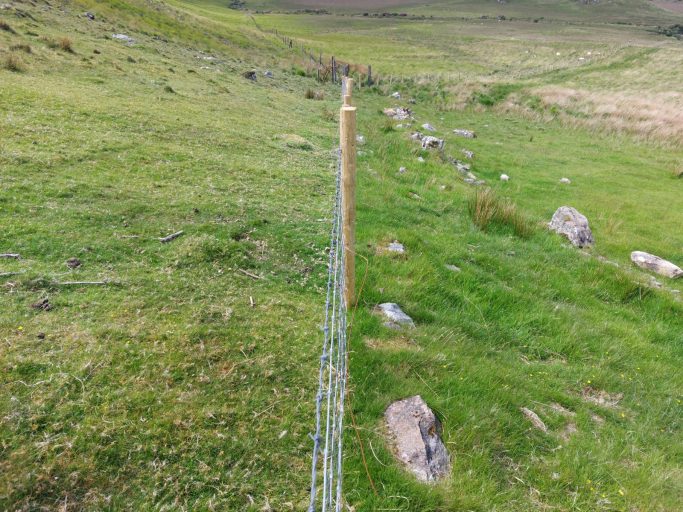
ABOVE: Sheep Exclosure
Project 02: Mweelin Exclosure
A former deer enclosure, previously used during the reintroduction of native Red Deer to the National Park in the 1980s, has been repurposed as a sheep exclosure to demonstrate the affect that grazing pressure has on upland habitats. EU protected priority habitats such as blanket bog, Rhyncosporion depressions (a threatened pioneer community found in peatlands), wet heath, calcareous and siliceous rocky slopes found within the National Park have been significantly negatively affected by intensive sheep grazing in the last few decades.
This project has been initiated in an attempt to allow approximately 60 acres (24 hectares) of hillside to recover from unsustainable grazing pressure. The highly sensitive habitats listed above will likely require several years to fully recover to good conservation status. This work may demonstrate the need for this management method across the whole National Park.

Project 03: New Found Wood
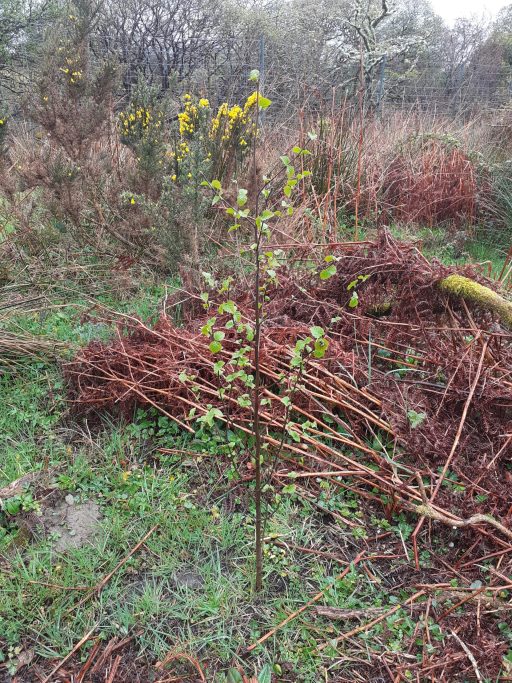
ABOVE: Tree Sapling
Project 03: New Found Wood
Located on the western side of the National Park, an area of 2 acres (0.81 hectares) of newly planted native woodland was created in 2020. The site was created to mitigate loss of established woodland along the N59, which was removed for road realignment purposes. The wood was named New Found Woodland in honour of our twinning with Terra Nova National Park in Newfoundland, Canada.
This plot is surrounded by a deer fence to protect young tree saplings from browsing by domestic and wild grazers. The tree species include Sessile Oak, Downy Birch, Rowan, Scots Pine, Hawthorn, Hazel, Alder and Aspen. Woodland flora such as Bluebell, Wood Sorrel, Lesser Celandine and Great Woodrush have already been recorded on the site since grazing by livestock has been removed.
It is hoped that this area of woodland will contribute to the very small percentage of woodland currently found in the National Park. It is envisaged that more woodland cover will be created within the National Park in time.

Project 04: Connemara Pony

Above: Connemara Pony
Project 04: Connemara Pony
Connemara ponies are a very important feature of the National Park, which has played an important role in the breeding of the animals since Erskine Childers, the late President of Ireland, presented a herd to the State in the 1980s.
The Pony Paddock along the Sruffaunboy is used as a display area for heritage breeds including the Connemara pony. We also hold regular Connemara pony information sessions during July and August where visitors can visit the Pony Stables, see a pony up close and learn more about the breed.
In 2019, a Connemara pony was gifted to Tannaghmore Rare Breeds Animal farm in Craigavon, Northern Ireland, in exchange for an Irish Moiled heifer. This collaboration was very important in raising awareness of the cultural and agricultural heritage of these heritage breeds, the importance of preserving them and their importance in the management and conservation of habitats in the National Park.

Project 05: Cladoir Sheep Preservation Committee
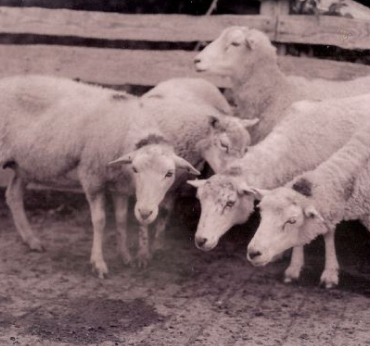
Above: Cladoir Sheep
Project 05: Cladoir Sheep Preservation Committee
Connemara National Park is a lead partner on the Cladoir Sheep Preservation Committee. Cladoir sheep were a native breed to Connemara but were widely believed to have been extinct, and only to be found as crossbred animals.
Thankfully, following DNA analysis of 65 sheep in 2020, it was found that 56 individuals had significant amounts of unique DNA attributed to the Cladoir breed, with the remaining nine having smaller amounts of DNA. Through a planned breeding programme it is hoped that the purity of the stock can be increased.

Project 06: Irish Moiled Cattle & Conservation Grazing
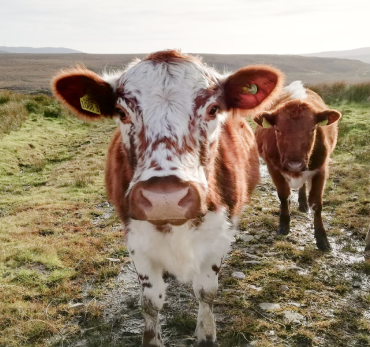
Above: Irish Moiled Cattle
Project 06: Irish Moiled Cattle & Conservation Grazing
In 2019 a Connemara pony was gifted to Tannaghmore Rare Breeds Animal farm in Craigavon, Northern Ireland, in exchange for an Irish Moiled heifer.
Tannaghmore Farm is the only Rare Breed Survival Trust approved farm in Ireland and is playing an important role in conservation of a number of native farm breeds that need protection including Irish Moiled cattle. These native breeds are used for conservation grazing in the management of a number of ecologically important properties in Craigavon.
Significant expertise has been acquired in management of certain species and habitat types, including in the control of some invasive species. Connemara National Park has developed a small herd of Irish Moiled cattle with a view to using this heritage breed for conservation grazing within the National Park.

Meet the Staff
Flora
Common and Rare Plants
Heather covers the mountainsides, with ling, cross-leaved heath and bell heather all very common. Probably the most abundant plant in the park is purple moor grass, which is responsible for the colour of much of the landscape throughout the year.
Insectivorous plants form an integral part of the bog community. Sundews and butterworts trap and digest insects with their leaves to gain nutrients, which are in short supply in the bogs.
Rare plant species from the colder areas of Europe and the Arctic may be found high up in the mountains, such as roseroot, purple and starry saxifrages, lesser twayblade, and mountain sorrel.
Conversely, plants from Spain and Portugal are also found in the park, notably pale butterwort, St. Dabeoc’s heath, which is a member of the heather family, and St. Patrick’s cabbage.
This native plant is found on blanket bog, in heathlands, and the wet grassland slopes of the uplands, as they thrive in either frequently or permanently wet ground. Visitors are most likely to spot this native plant in the summer season when its leaves and leaf sheaths are often tinged purple.
This plant can be seen flowering from June to August and is commonly found on boggy ground and wet heaths throughout the National Park. Due to the type of habitat, there are very few nutrients to support growth and it has adapted to other methods. On the leaves you can see hairs with a little drop of ‘dew’. This is what captures the insects, which the sundew then turns into their food.
In the past, sundews were used as a cough remedy and they are still used as an ingredient in modern day cough mixtures.
This small plant can be found in the Park during the summer season, as it flowers from May to August. The habitats of the National Park are perfect for this native plant, as it thrives in bogs, wet rocks and mountain heaths. Although it may not look it, this Butterwort is in fact carnivorous, where insects get trapped on its sticky lime colour leaves, slowing decomposing and passing on nutrients that can’t be obtained from its habitat.
Another summer flowering plant, if you are lucky you will catch roseroot flowering amongst the rocks of the National Park from May to August. It is mostly a coastal plant, occurring throughout the country on ledges of sea cliffs and mountains close to the sea. Roseroot is not easily found in the National Park due to where they grow.
Purple saxifrage is a small plant that grows in mountainous locations: either on wet rock ledges, cliffs, by mountain streams or in rock crevices. The mountainous terrain within the National Park provides perfect conditions for this plant where damp conditions and acid soils prevail. It can be seen anytime from April to August. Purple saxifrage is not easily found in the National Park due to where they grow.
Starry saxifrage is similar to purple saxifrage and they are from the same family of plants. They grow in mountainous locations: either on wet rock ledges, cliffs, by mountain streams or in rock crevices. The mountainous terrain within the National Park provides perfect conditions for this plant where damp conditions and acid soils prevail. Flowering from June to August, Starry saxifrage is not easily found in the National Park due to where they grow.
The heather, moss and wet woodland areas of the park are perfect habitat conditions for this plant. It flowers from June to August. Like other orchids, this native plant relies on fungi to grow and for nutrition. However, once its leaves are fully formed, the Lesser Twayblade switches methods, relying on photosynthesis for the rest of its blooming season.
This plant flowers in summer, and can be seen in the National Park from May to August. It’s a species of flowering plant from the buckwheat family, and is found predominately in the mountainous regions of the national park.
The smallest of the Butterwort family in Ireland, this carnivorous plant can often be found amongst the damp heaths of the National Park. This plant is to be found in flower from June to September.
This native plant is found predominately in the west of Ireland. This low growing shrub is found in dry heath habitats and rocky outcrops within the National Park. It can be seen in the summer and autumn seasons as it flowers from May to October.
Like St. Daboec’s heath, this native plant is predominantly found in the western parts of Ireland. It flowers from May to August. This plant favours rocky habitats and to help maintain a grip its leaves take the form of a basal rosette.
Habitats
Western blanket bog and heathland are the predominant vegetation types found in the park. The boglands, situated in the low-lying areas, are normally very wet, while higher up the mountains, a drier community of mountain blanket bog develops.
Uplands
Though predominately mountainous and rocky, the uplands at Connemara National Park are home to a range of fascinating flora and fauna. You may spot some native Red Deer or a heritage breed such as Old Irish Goats amongst the heather and grasslands that cover the area. Due to the higher altitude, the bog and heathlands tend to be drier compared to that of the lower boglands.
Boglands
Bogs are a key feature of the landscape of Connemara National Park. The western blanket bog found in the National Park has a grass-like appearance due to the purple moor grass that surrounds it. Key features of these blanket bogs include surfaces of pools, flushes, flat and sloped inclines. Swallow holes are also a feature and to be watched out for if going off trail in the National Park.
Fauna
Connemara National Park has a wealth of wildlife. There is a variety of bird and mammals species to discover in the National Park, alongside our Heritage Breeds.
The birdlife of the park is varied, including common songbirds like meadow pipits, skylarks, stonechats, chaffinches, robins and wrens. Birds of prey are sometimes seen, usually kestrel and sparrowhawk, with merlin and peregrine falcon making occasional visits.
Winter brings an increase in the numbers of the species native to Ireland such as woodcock, snipe, starling, song thrush and mistle thrush, augmented by visitors from other parts of Ireland and abroad, as well as winter migrants from northeastern Europe, such as redwing and fieldfare.
Badgers, foxes, pine marten and bats are often observed at night. Other mammals seen in the National Park include red deer, otters, hares, stoats, wood mice and pygmy shrews.
The largest mammal in the park is the Connemara pony. Although a domestic animal, this pony is very much part of the Connemara countryside.
The variety of habitats in Connemara National Park means that it can support a diverse range of species whether in the mountains of our uplands or lowland woodlands and grasslands. The rivers are home to trout, salmon and freshwater pearl mussel.
Connemara is also home to two of the three amphibian species that can be found in Ireland: the common frog and the smooth newt.
Heritage Breeds
Connemara National Park is a member of the Irish Native Rare Breed Society, dedicated to the promotion of indigenous breeds of domesticated livestock that include Connemara Ponies, Moiled Cattle, Cladoir Sheep, Galway Sheep and Old Irish Goats. Management at the National Park are also working closely with Fingal County Council and Newbridge House & Demesne in development of a heritage breeds programme and visitor experience at Connemara National Park.
Find out more about our work and how we collaborate with partner organisations to conserve heritage breeds in our conservation projects below.
Geology
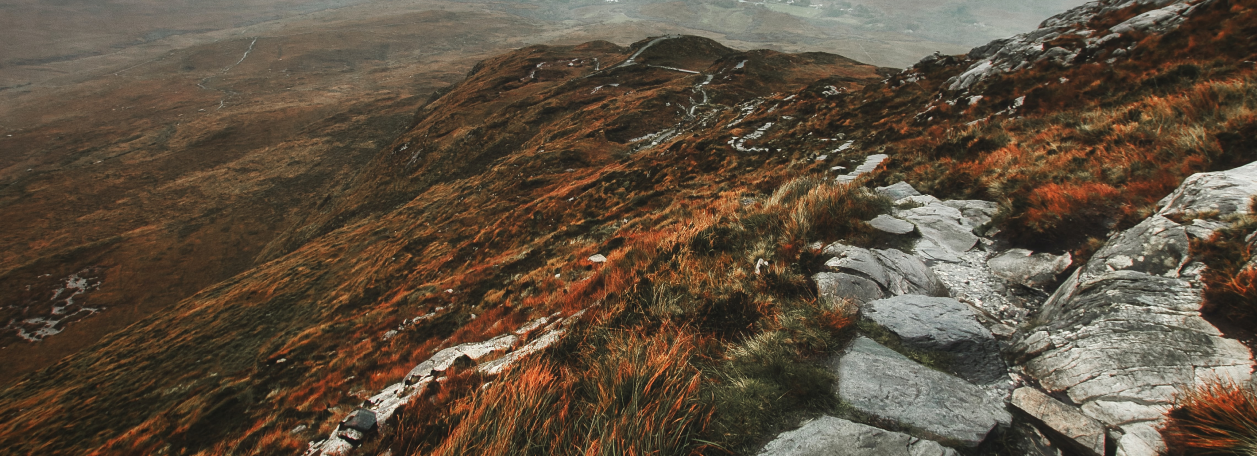
Underlying the National Park are metamorphic rocks that are typical of the Twelve Bens area. These rocks derive from sediments deposited in a warm shelf sea between 700 and 550 million years ago.
Upheavals in the Earth’s crust formed the sediments into crystalline schists within the roots of an elongated mountain belt. Regional uplift and erosion have since brought the rocks to the surface.
The mountain tops are mostly of more resistant quartzite, while the flanks consist of less resistant schists and grey marbles. The last ice age, which ended about 10,000 years ago, imposed a final shaping to the landscape and left behind localised deposits of sand and gravel, widespread boulder clay and erratic boulders.
These features largely determine the pattern of plant communities in the park.
Archaeology & Historical Antiquitues
Connemara National Park holds an array of sites of archaeological and historical significance, some dating back thousands of years, highlighting the rich histroy of the National Park lands and their long human habitation.
Helen Riekstins (National Park Guide & Archaeologist) has been undertaking an archaeological survey of the park since 2017. To date 13 new sites have been recorded, adding to the two megalithic tombs that were already known. Six of the new sites have been checked by the National Monuments Service (NMS) of the Department of Housing, Local Government and Heritage.
These sites include a cairn, standing stone, house, enclosures, pre-bog wall and nearby hut. The remaining seven sites have all been scheduled for inclusion in the next revision of the Record of Monuments and Places (RMP), as shown on the public viewer. See more in the downloadable guide.
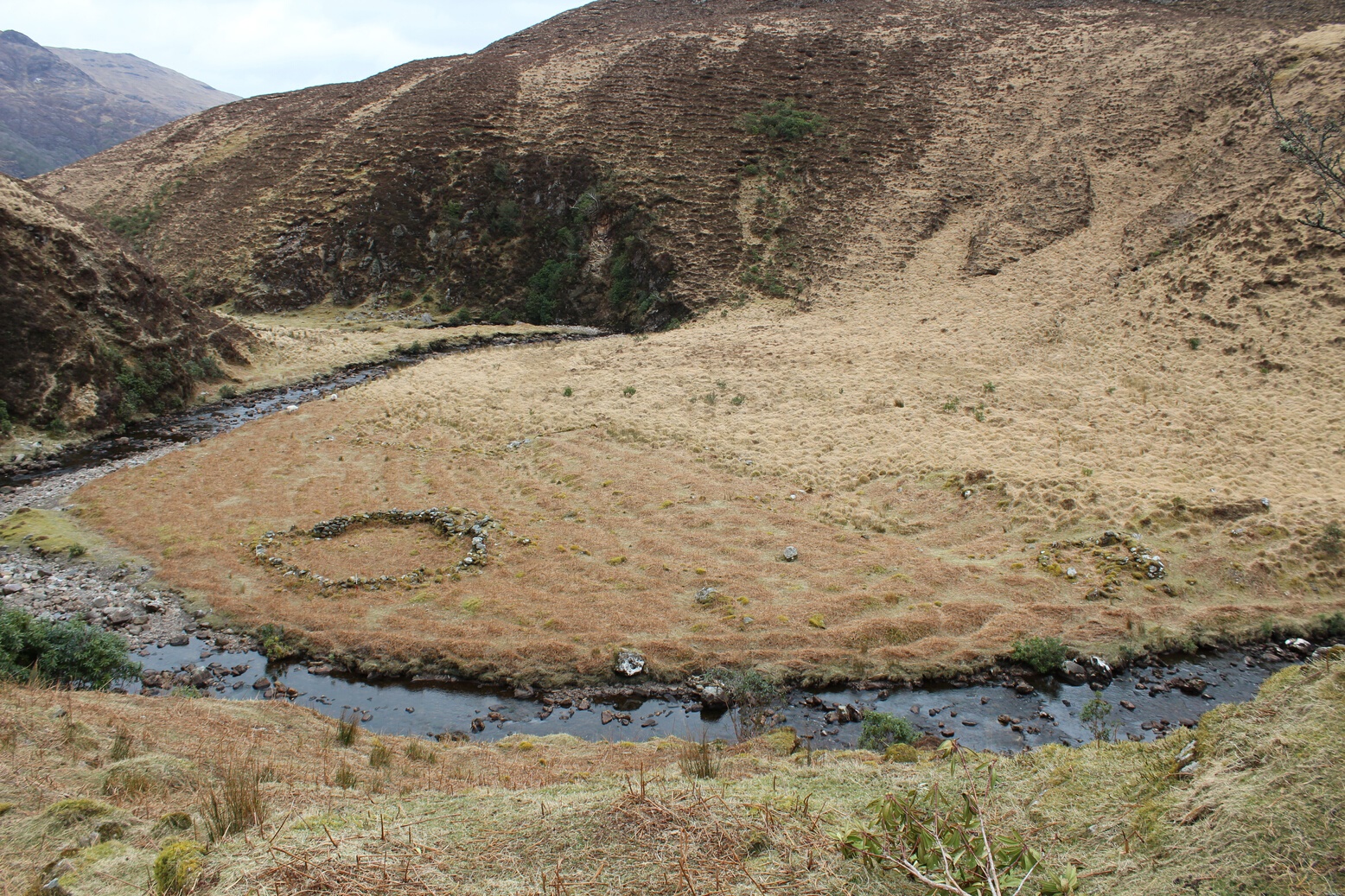
Other Protected Sites
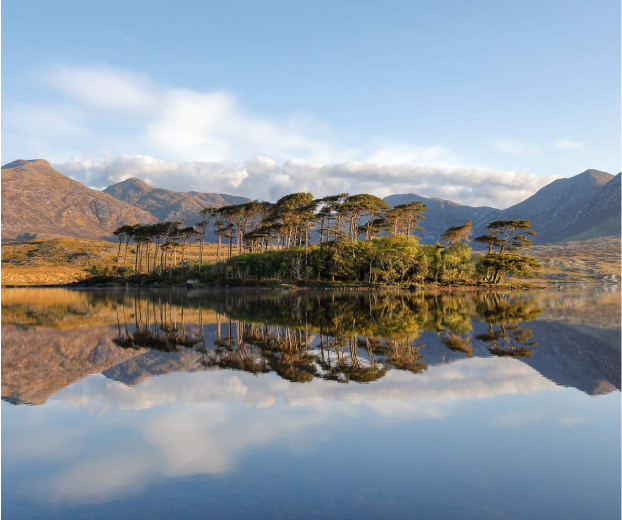
ABOVE: Derryclare Lough
Knockma Wood, Belcare, Co. Galway and Derryclare Nature Reserve, Inagh, Co. Galway are two other protected sites of cultural and historical significance that are within close vicinity to the National Park.








